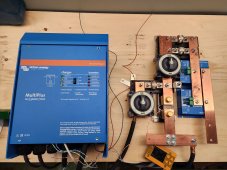pelicanpebble
New Member
- Joined
- Sep 4, 2022
- Messages
- 13
I have a 4S LiFePO4 battery bank from which I need to draw 400A for about 3-5 minutes.
After some discussion with JBD, they concluded that none of their BMS will work for me.
Hence my latest idea: Can I use a modified low-current split-port BMS to drive my charge and discharge relays? And of course the relays are bistable to make matters less straight-forward...
The basic idea is as follows:

And modify it to look a bit like this (obviously heavily simplified):

Could this work? Has anybody tried this?
Obviously this would not work with a single-port BMS since they always switch both mosfets after a short delay to avoid heating due to the body diode. For my idea to work, the BMS must switch e.g. the discharge mosfet only if it wants to discharge and not during charging as well...
I would welcome any comments.
After some discussion with JBD, they concluded that none of their BMS will work for me.
Hence my latest idea: Can I use a modified low-current split-port BMS to drive my charge and discharge relays? And of course the relays are bistable to make matters less straight-forward...
The basic idea is as follows:
- Remove the charge and discharge mosfets
- Remove the current sense resistors
- Use the mosfet gate drive line to switch a relay-driver circuit for the bistable relays
- Use the current sense voltage lines to connect to a new external current shunt
- Recalibrate the BMS to the new shunt value
And modify it to look a bit like this (obviously heavily simplified):
Could this work? Has anybody tried this?
Obviously this would not work with a single-port BMS since they always switch both mosfets after a short delay to avoid heating due to the body diode. For my idea to work, the BMS must switch e.g. the discharge mosfet only if it wants to discharge and not during charging as well...
I would welcome any comments.




